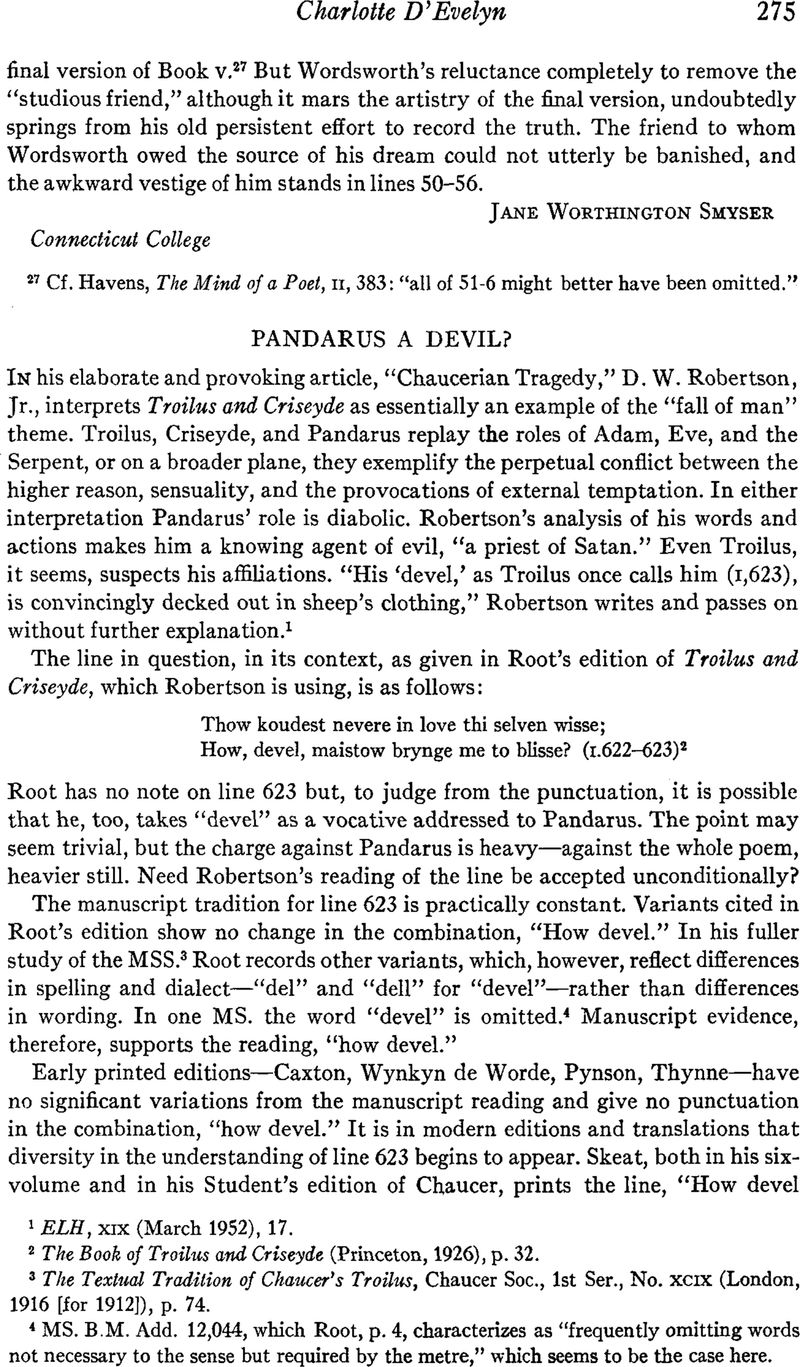No CrossRef data available.
Published online by Cambridge University Press: 02 December 2020

1 ELU, xix (March 1952), 17.
2 The Book of Troilus and Criseyde (Princeton, 1926), p. 32.
3 The Textual Tradition of Chaucer's Troilus, Chaucer Soc, 1st Ser., No. xcix (London, 1916 [for 1912]), p. 74.
4 MS. B.M. Add. 12,044, which Root, p. 4, characterizes as “frequently omitting words not necessary to the sense but required by the metre,” which seems to be the case here.
5 Walter W. Skeat, The Complete Works of Geoffrey Chaucer (Oxford, 1894), ii, 172; vi, 70.
6 Alfred W. Pollard, The Works of Geoffrey Chaucer (London, 1898, 1928), p. 447.
7 F. N. Robinson, The Complete Works of Geoffrey Chaucer (Boston, 1933), pp. 461, 1067.
8 Chaucer: Troilus and Criseyde (Oxford, 1935), pp. xxxii, 7.
9 Geoffrey Chaucer: Troilus and Criseyde (London, 1953), pp. vii, 26.
10 John S. P. Tatlock and Percy MacKaye, The Complete Poetical Works of Geoffrey Chaucer (New York, 1912; repr. 1928), p. 387.
11 Geoffrey Chaucer: Troilus and Cressida (New York, 1932), quoted in 3rd printing, p. 25.
12 The Portable Chaucer (New York, 1949), p. 388.
13 Geoffrey Chaucer's Troilus and Criseyde (Columbia, S. C, 1952), p. 18.
14 Nathaniel Edward Griffin and Arthur Beckwith My rick, The Filostrato of Giovanni Boccaccio: A Translation with Parallel Text (Philadelphia, 1929), p. 166.
15 Robinson, p. 611.
16 Edgar Finley Shannon, Chaucer and the Roman Poets (Cambridge, 1929), p. 296, and Sanford Brown Meech, “Chaucer and an Italian Translation of the Heroides,” PMLA, xlv (1930), 123 f.
17 The couplet, ll. 1238–39, is not given in the Ellesmere MS. Manly, Canterbury Tales by Geoffrey Chaucer (New York, 1928), p. 652, remarks that the lines are “so Chaucerian in manner that they are usually admitted into the text.”
18 Tatlock and MacKaye, p. 289; R. M. Lumiansky, The Canterbury Tales by Geoffrey Chaucer (New York, 1948), p. 368; Nevill Coghill, Geoffrey Chaucer, The Canterbury Tales (Baltimore, 1952), p. 492.
19 Max Kaluza, The Romaunt of the Rose, Chaucer Soc, 1st Ser., No. lxxxiii (London, 1891; repr. 1928), pp. 357, 389. The only surviving authorities for the text are the Glasgow MS. and Thynne's ed. No variants are cited by Kaluza or Skeat.
20 See Kaluza's parallel text, pp. 356, 388.
21 Le Roman de la Rose, iii, SATF (Paris, 1921), p. 186, l. 11087; p. 204, l. 11525.
22 The Romance of the Rose, Temple Classics (London, n.d.), ii, 134, l. 11583; 154, l. 12175.
23 Le Roman de la Rose mis en français moderne (Paris, 1928), pp. 193, 201. The 1949 ed., p. 199, punctuates the 2nd instance, “Que diable me chantes-tu là?”
24 Under how, adv. I. b. the NED quotes Caxton ca. 1489 as its earliest example of “how the devil.”